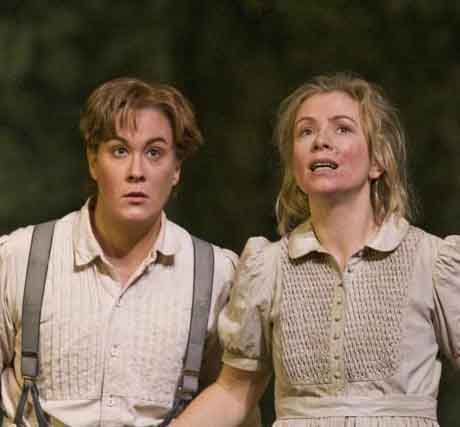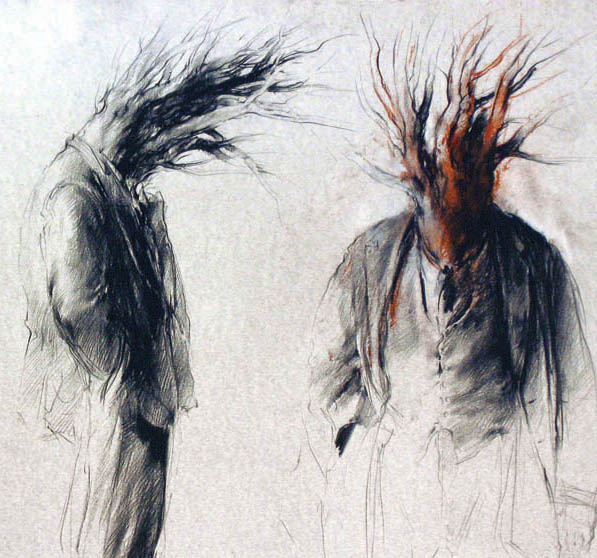Key Word Search
Multi-Field Search
Browse
Repertory Report
Performers Report
Contacts
Met Opera Website
New Production
Hänsel und Gretel
Metropolitan Opera House, Mon, December 24, 2007 Matinee
Debut : Richard Jones, John Macfarlane
In English
Hänsel und Gretel (240)
Engelbert Humperdinck | Adelheid Wette
- Hänsel
- Alice Coote
- Gretel
- Christine Schäfer
- Gertrud
- Rosalind Plowright
- Peter
- Alan Held
- Witch
- Philip Langridge
- Sandman
- Sasha Cooke
- Dew Fairy
- Lisette Oropesa
- Conductor
- Vladimir Jurowski
- Production
- Richard Jones [Debut]
- Designer
- John Macfarlane [Debut]
- Lighting Designer
- Jennifer Tipton
- Choreographer
- Linda Dobell
The production was originally created for Welsh National Opera and Lyric Opera of Chicago
Hansel and Gretel received nine performances this season
Production photos of Hansel and Gretel by Ken Howard/Metropolitan Opera.
Designs for Hansel and Gretel by John Macfarlane.
FUNDING:
The production a gift of the Gramma Fisher Foundation, Marshalltown, Iowa and Karen and Kevin Kennedy
Additional funding provided by Dr. Coco Lazaroff and Joan Taub Ades and Alan M. Ades
Review 1:
Review of F. Paul Driscoll in the March 8, 2008 issue of OPERA NEWS
Robert Jones brought a sweet-and-sour "Hansel and Gretel" to the Met, sharp edged and short on sugar.
The Metropolitan Opera's connection to Engelbert Humperdinck's "Hänsel und Gretel" stretches back to 1905, when Alfred Hertz conducted the opera's company premiere in the presence of the composer. On Christmas Day 1931, the Met's one-hundred-twenty-fifth "Hänsel" inaugurated the company's still-current series of live Saturday-matinee radio broadcasts; some fifty-one Christmases later, in 1982, the company did its first Hansel telecast, bringing to an audience of millions the gingerbread-rich Nathaniel Merrill-Robert O'Hearn production that defined the opera at the Met for more than thirty years. Christmas 2007 marked another "Hansel" milestone for the company, when an unconventional new production - the second installment in the Met's annual series of holiday presentations-had its premiere at the December 24 matinee (followed by an HD transmission on January 1).
Directed by Richard Jones, with costumes and sets designed by John Macfarlane, and sung in David Pountney's superb English-language translation, the new "Hänsel" was originally co-produced by Welsh National Opera and Lyric Opera of Chicago; it was also presented by San Francisco Opera in 2002-2003. In all of its previous incarnations, this singular "Hänsel" has been cited as a "dark" interpretation of Humperdinck's opera - a label no doubt inspired by Jones's bold, deliberate rejection of the cozy evergreen-and-sugarplum decors that have made "Hänsel und Gretel" an anodyne Christmastime perennial since its world premiere, in 1893. Jones's staging is a sweet-and-sour "Hänsel," sharp-edged and short on sugar. An extremely sophisticated combination of elegant fantasy - as in Act II's deep-green forest-patterned room, in which Magritte-ish chefs in outsized toques take the place of the libretto's fourteen angels - and knockabout comedy of the "food fight" variety, the new Met staging embraces "Hänsel und Gretel" as an opera suitable for adults.
Jones sees "Hänsel und Gretel" as an opera about hunger and the need to satisfy it, so he sets each act in a different "kitchen." The broom-maker's cottage in Act I is a drab, dingy apartment kitchen; Act II's woods near the Ilsenstein mountain are a dark-green dining chamber staffed by footmen with branches for heads; the witch's gingerbread house is a vast industrial food-prep space. For some smaller children, this lack of correspondence to the icons of storybook illustration may prove off-
putting, but most of the youngsters in the premiere audience seemed to have little or no trouble following the onstage action; they certainly responded with vigor when flour and cocoa were tossed around in the witch's kitchen, and when that redoubtable lady landed inside the oven.
Vladimir Jurowski's first-class command of the Met's orchestral forces gave full, uninhibited play to the score's rhythmic variety and Wagnerian depth of color, but the artists under his baton - all of them inhabiting the rough-and-tumble world of Jones's mise-en-scène with commendable abandon - met the vocal challenges of their assignments with varying degrees of success. On the credit side, Philip Langridge was a brilliantly funny villainess "en travesti," singing with admirable point and looking not unlike Dame Margaret Rutherford in her Miss Marple days, his flair for character detail as telling as ever. (The quick, fussy little pat Langridge gave to his flour-marked skirt as he lumbered off the kitchen table was priceless.) Alice Coote's hyperactive but beautifully phrased Hansel was an impressive change from her aristocratic Sesto in last season's "Giulio Cesare." Alan Held, luxuriously cast as Peter, boomed with character, authority and clarity. Deft cameos were contributed by mezzo Sasha Cooke, as a gnarled-looking, amber-toned Sandman, and Lisette Oropesa, a brightly bossy Dew Fairy, clad in a 1950s housedress and Playtex gloves. The Met's children's chorus did their bit brightly in the last scene, although the resurrection of the witch's gingerbread gallery might have been managed with a bit more magic than a pulled curtain.
Christine Schäfer, one of opera's loveliest lyric sopranos, was a feisty, fierce little Gretel who was, alas, almost wholly unintelligible in her delivery of the English text and often inaudible into the bargain. Fully audible, but even less intelligible, was veteran soprano-turned-mezzo Rosalind Plowright, whose harsh singing and gauche acting made Gertrude a needlessly unsympathetic figure.
Search by season: 2007-08
Search by title: Hänsel und Gretel,
Met careers
- Vladimir Jurowski [Conductor]
- Alice Coote [Hänsel]
- Christine Schäfer [Gretel]
- Rosalind Plowright [Gertrud]
- Alan Held [Peter]
- Philip Langridge [Witch]
- Sasha Cooke [Sandman]
- Lisette Oropesa [Dew Fairy]
- Richard Jones [Production]
- John Macfarlane [Designer]
- Linda Dobell [Choreographer]
- Jennifer Tipton [Lighting Designer]

